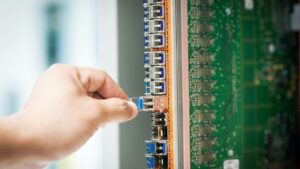Connection Hub
 In today’s fast-paced digital world, staying connected is more crucial than ever. Enter the “connection hub”—an innovative solution designed to streamline communication and collaboration across various platforms. Whether it’s for a bustling corporate office or a remote work setup, a connection hub ensures seamless integration of devices and networks.
In today’s fast-paced digital world, staying connected is more crucial than ever. Enter the “connection hub”—an innovative solution designed to streamline communication and collaboration across various platforms. Whether it’s for a bustling corporate office or a remote work setup, a connection hub ensures seamless integration of devices and networks.
A connection hub isn’t just about linking gadgets; it’s about creating a unified environment where information flows effortlessly. This technology empowers individuals and teams to work more efficiently, breaking down barriers that once hindered productivity. Discover how a connection hub can revolutionize the way you connect, communicate, and collaborate.
What Is a Connection Hub?
A connection hub integrates various devices and networks into a single platform. It ensures seamless communication and collaboration by linking gadgets like smartphones, laptops, and tablets with corporate networks and remote servers. This integration fosters a unified  environment for information flow, streamlining operations.
environment for information flow, streamlining operations.
Connection hubs support multiple communication protocols, making them versatile tools in both corporate offices and remote settings. They bridge different technologies, enabling efficient data transfer and resource sharing.
Use cases include project management, customer support, and virtual meetings. For instance, teams can collaborate on projects in real-time regardless of location, improving efficiency and productivity.
Key Features of a Connection Hub
A connection hub integrates various devices and workflows, facilitating seamless collaboration and data sharing. Key features include diverse connectivity options, a user-friendly interface, broad compatibility, and robust security measures.
Connectivity Options
Connection hubs support multiple communication protocols, enabling devices like smartphones, laptops, and tablets to link effortlessly. These hubs often feature Wi-Fi, Bluetooth, Ethernet, and USB-C connections. For example, a conference room connection hub might allow seamless transition between wired and wireless networks without interruption. This versatility ensures quick, efficient data transfer and connectivity across different environments.
User-Friendly Interface
A user-friendly interface ensures that individuals can easily connect their devices and manage settings. Modern dashboards display device status, network connections, and usage statistics clearly. For example, touchscreens might provide prompts for connecting new devices, adjusting network settings, and managing user access. This intuitive design reduces the learning curve, making it easier to use for people with various technical backgrounds.
Compatibility
Connection hubs offer compatibility across multiple operating systems and devices. Whether using Windows, macOS, iOS, or Android, these hubs support seamless integration. For instance, a remote worker can connect their laptop and smartphone to the same hub without encountering compatibility issues. This broad compatibility promotes inclusivity and allows organizations to streamline their tech ecosystems.
Security Measures
Advanced security measures are crucial for connection hubs to protect data integrity and privacy. Features include encryption, firewalls, and access controls. For example, enterprise-grade hubs might feature end-to-end encryption for data transfer, ensuring sensitive information remains secure. Regular software updates also help to patch vulnerabilities and enhance defenses against cyber threats, safeguarding organizational data.
Benefits of Using a Connection Hub
Connection hubs offer numerous advantages that enhance various aspects of both individual and team operations in any environment.
Enhanced Productivity
Connection hubs streamline communications and data sharing, leading to increased productivity. By integrating diverse devices and networks, these hubs eliminate barriers to real-time collaboration. Teams can access shared resources instantly, reducing downtime. For instance, project management becomes more efficient when team members can upload, edit, and access documents simultaneously.
Centralized Management
Centralized device and network management is another notable benefit. Connection hubs consolidate control, allowing IT administrators to manage device connections and monitor network activity from a single interface. This centralization simplifies troubleshooting and ensures seamless operations. For example, updating software across multiple devices can be done simultaneously, reducing manual effort.
Cost-Effectiveness
 Connection hubs offer cost savings through efficient resource utilization. Reduced operational costs arise from the elimination of redundant systems. Organizations can avoid the expense of maintaining multiple disparate networks and devices. Additionally, enhanced efficiency often translates to lower operational costs, as seen in companies that have streamlined workflows through connection hubs, cutting unnecessary expenses.
Connection hubs offer cost savings through efficient resource utilization. Reduced operational costs arise from the elimination of redundant systems. Organizations can avoid the expense of maintaining multiple disparate networks and devices. Additionally, enhanced efficiency often translates to lower operational costs, as seen in companies that have streamlined workflows through connection hubs, cutting unnecessary expenses.



